7 Best Barbell Bench Press Variations (with Pictures!)
The bench press may be one of the most popular barbell exercises out there - so much so, that quite a number of different variations have been developed over the years.
Because of the sheer number of variations available, it can be quite difficult deciding on which specific one to incorporate into your training program. In order to aid with this decision, we’ve listed the most popular and effective barbell bench press variations in this article.
Of course, it goes without saying that you should first master the conventional flat bench press prior to attempting any other variation. This is both for your own safety, as well as to ensure that you have the necessary upper body strength to perform the more difficult forms of the bench press.
What is a Bench Press?
The standard definition of a bench press defines it as a free weight exercise involving the lifter pressing a weight horizontally upwards while lying on their back. This is primarily done so as to train the pectorals, triceps and anterior deltoids.

The majority of bench press variant exercises simply change the angle of resistance or stance involved, thereby altering what muscles are emphasized by the movement.
Prior to trying out other bench press variations, it is vital to first master proper flat bench press form - paying close attention to bar touchpoint, proper scapular retraction and pressing the bar upwards in a bilateral manner.
Bench Press Variations
1. The Conventional Flat Bench Press
The conventional flat bench press is the quintessential form of bench press, featuring a horizontal body orientation and an even distribution of training stimulus between the anterior deltoids, chest and triceps.
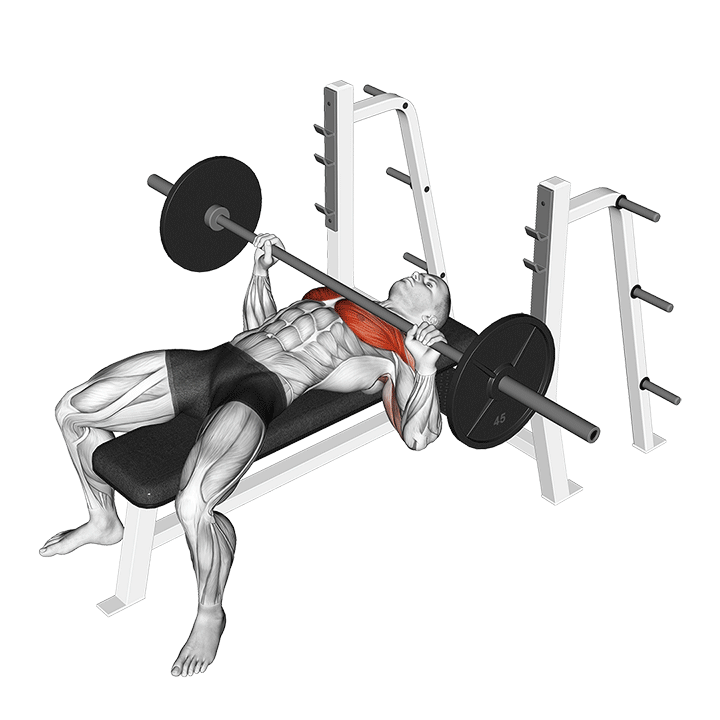
Like most other bench press variations, the flat bench press is an open chain compound movement that primarily utilizes elbow extension as the main biomechanic involved.
The conventional bench press occasionally differs between different training disciplines, especially in regards to powerlifting where additional strategies like the usage of a lower back arch, heel/leg drive and a somewhat different bar path can help maximize weight lifted.
Muscles Worked
The flat bench press primarily works the anterior (front-facing) deltoid heads, the pectoral muscles and the triceps brachii.
Benefits as a Bench Press Variation
The flat bench press is considered to be the “default” bench press with which one should master prior to attempting different variations. It allows the lifter to build familiarity with general chest press mechanics, and helps build a baseline of muscular strength in the upper body.
In addition, the flat bench press is considered to be one of the best exercises for developing overall push muscle mass and strength.
How-to:
To perform a flat bench press, the lifter will lie atop a bench, barbell racked over the eyes so it is suspended over the chin when unracked.

The proper bench press stance involves the lifter pinning their shoulder blades beneath the torso, setting the feet securely on the floor, and their hands a comfortable distance wider than shoulder-width apart along the bar.
Now in the correct stance, the lifter unracks the barbell and slowly lowers it to the correct touchpoint around the center of their chest, keeping the forearms and elbows aligned beneath the bar as they do so.
Once the bar makes contact with the chest, the lifter squeezes their pectoral muscles and pushes through their wrists - pressing the barbell upwards until their arms are fully extended.
This completes the repetition.
2. The Decline Bench Press
The decline bench press is a bench press variation where the body is oriented at a decline angle - meaning that the head will be pointed towards the floor, often with the hips and legs at a higher elevation.
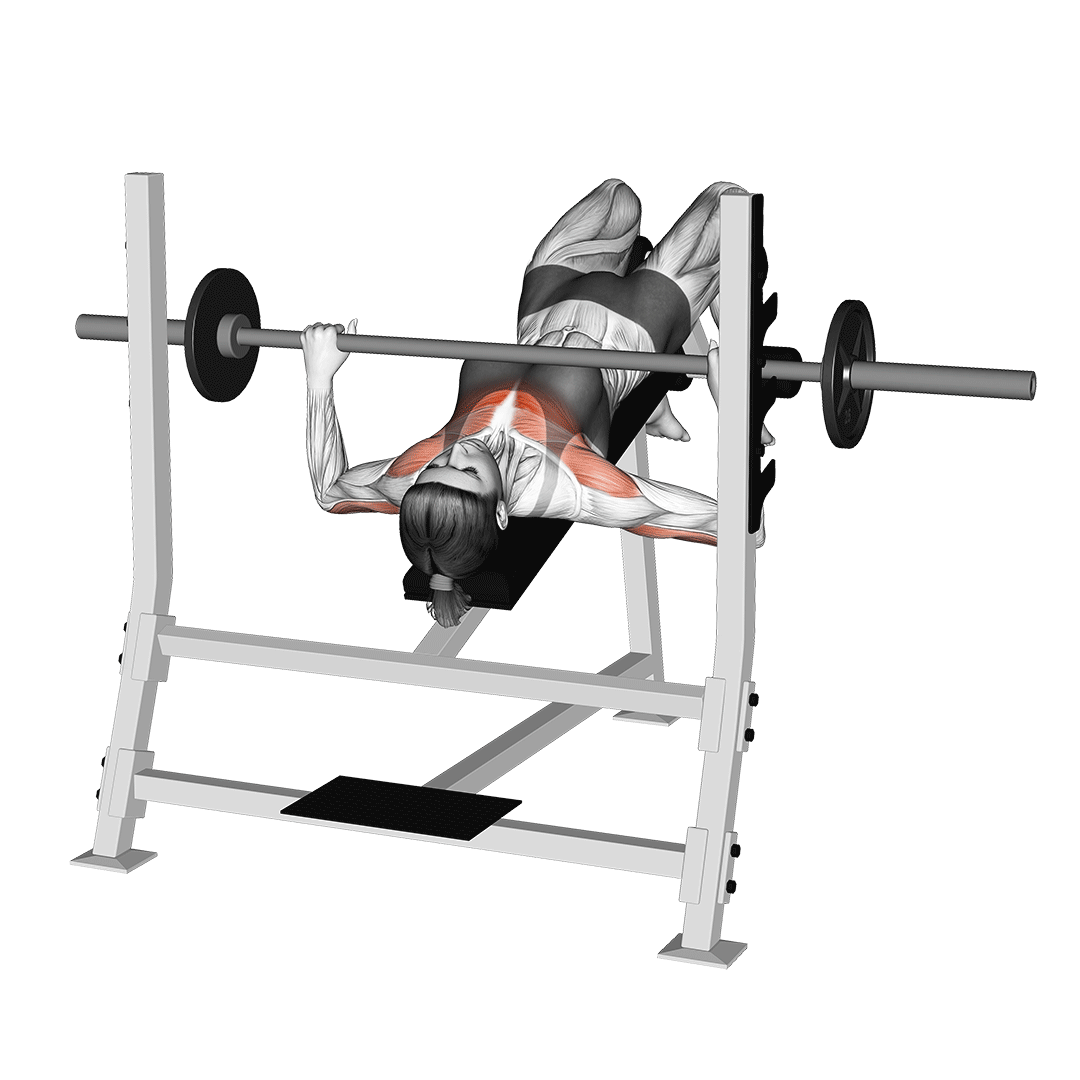
Torso orientation aside, the decline bench press also differs from the conventional bench press by featuring a slightly different touch point and somewhat greater emphasis on the lower pectoralis major.
In most other aspects, the decline bench press is mechanically identical to its flat counterpart. Marked use of elbow extension, general recruitment of the upper body’s push musculature and traditional usage of a loaded barbell.
Muscles Worked
The decline bench press works much the same muscles as any other bench press variation - that being the pectorals, deltoids and triceps brachii. However, the decline bench press is most often preferred in situations where greater lower chest recruitment is needed.
Benefits as a Bench Press Variation
The decline bench press features a slightly shorter range of motion and altered angle of resistance in comparison to other bench press variants. This allows for more weight to be lifted - making the decline press excellent for maximizing loading.
Furthermore, as previously mentioned, the decline press is most often used as a method of emphasizing the lower chest. Bodybuilders seeking greater lower chest definition or powerlifters with a sticking point due to a weak lower pectoralis major can both benefit from this emphasis.
How-to:
To perform a repetition of the decline bench press, the lifter will angle a decline bench at approximately a 15-30 degree decline, lying atop it and hooking their feet into the pads for stability.
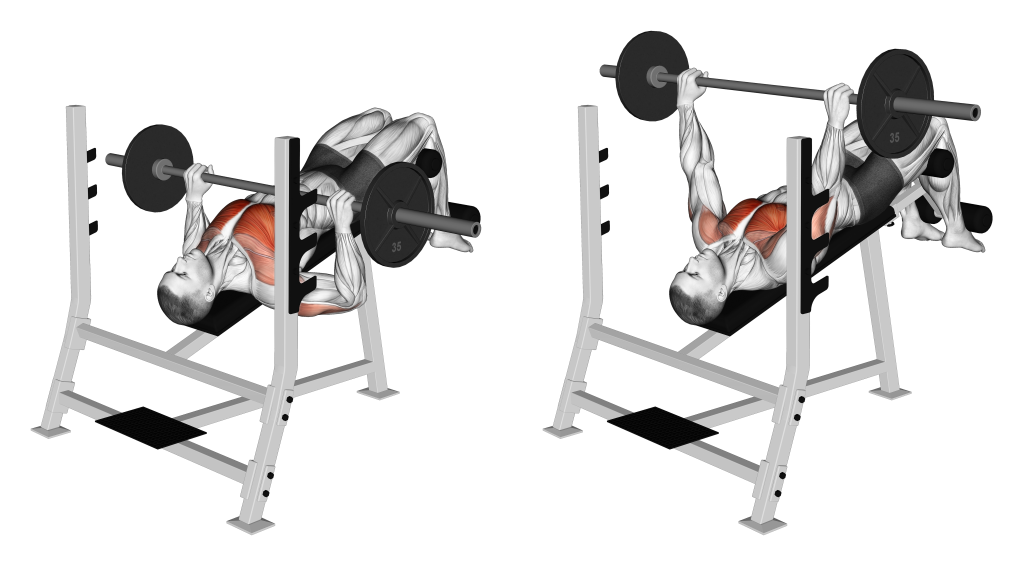
Now in an angled orientation, the lifter will adopt the standard bench press stance - scapula retracted, hips pressed against the bench, hands slightly wider than shoulder-width apart along the barbell.
Unracking the bar, the lifter will slowly lower the bar until it touches somewhere around the lower section of the sternum.
Once the bar makes contact, the lifter will squeeze their pectorals and press the bar back upwards. When the arms are fully extended, the repetition is considered complete.
The decline bench press may call for a different touch point and bar path than the flat bench press. This will depend on the lifter’s arm length, shoulder mobility and the actual angle in which the body is oriented.
3. The Incline Bench Press
As a direct contrast to the decline bench press, the incline bench press instead places the torso at a more upright angle - thereby emphasizing the anterior deltoids and upper section of the pectoralis muscle group to a greater extent.
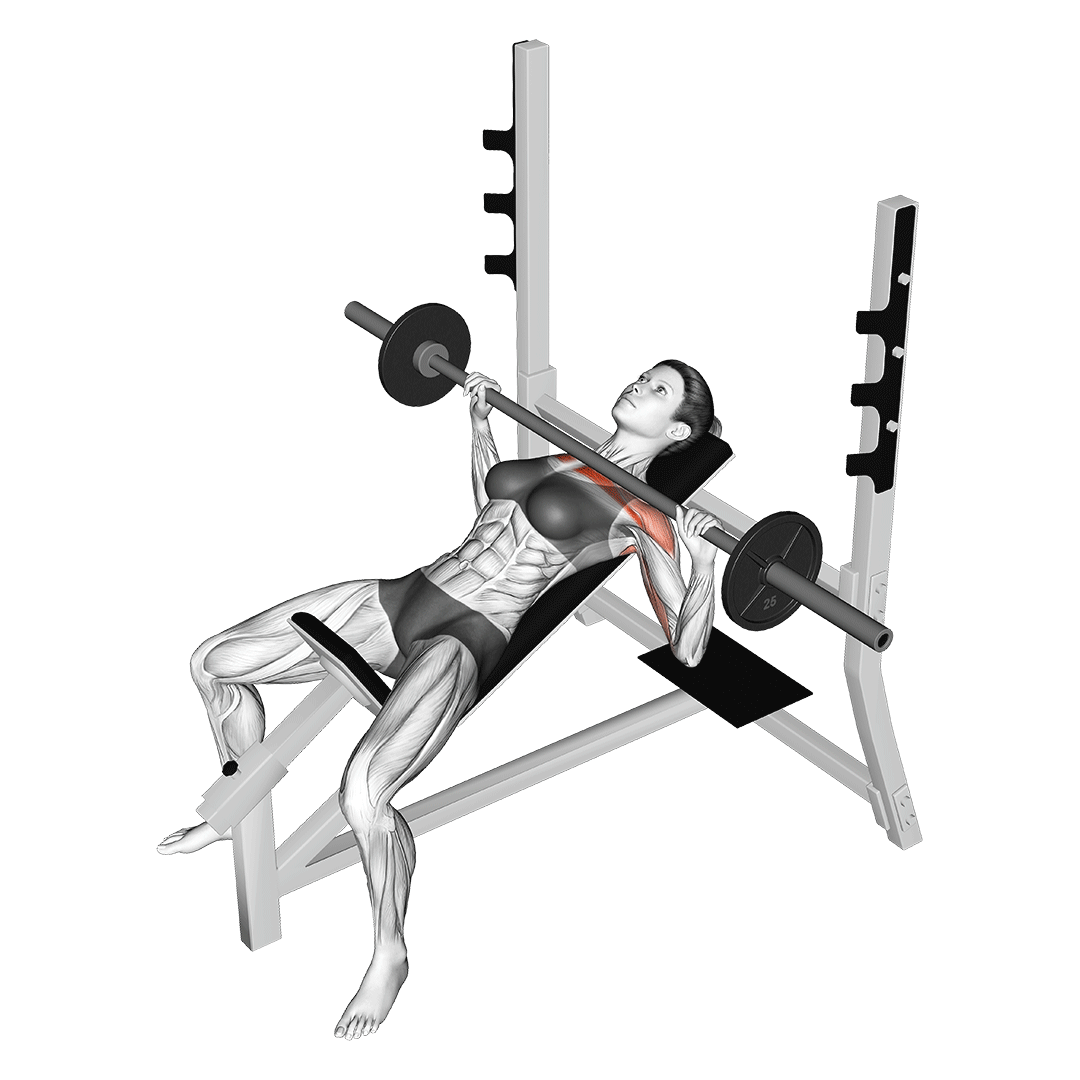
Apart from a more upward bar path and minor shift in muscle recruitment, the incline bench press follows much the same mechanics and stance as the previously mentioned bench press variations. This includes marked use of elbow extension, unilateral movement pattern and general recruitment of the upper body’s push muscles.
Despite this similarity however, the incline bench press is more often used as a method of building upper chest mass and definition, rather than as the primary form of bench press in a training program.
Muscles Worked
The incline bench press emphasizes the anterior deltoid head, the clavicular head of the pectoralis major and the pectoralis minor to a greater degree than other bench press variations. Of course, this is in addition to the rest of the pecs and the triceps brachii.
Benefits as a Bench Press Variation
The main benefit of the incline bench press is its greater emphasis of the upper chest - of which is often found to be lacking in lifters who primarily perform the flat variation of the bench press.
Chest development aside, the incline press is also quite popular as an accessory movement for directly improving shoulder press and flat bench press performance.
How-to:
To perform an incline bench press, the lifter will set an incline bench at an approximate 15-30 degree angle, sitting atop it and pinning their shoulder blades beneath them.
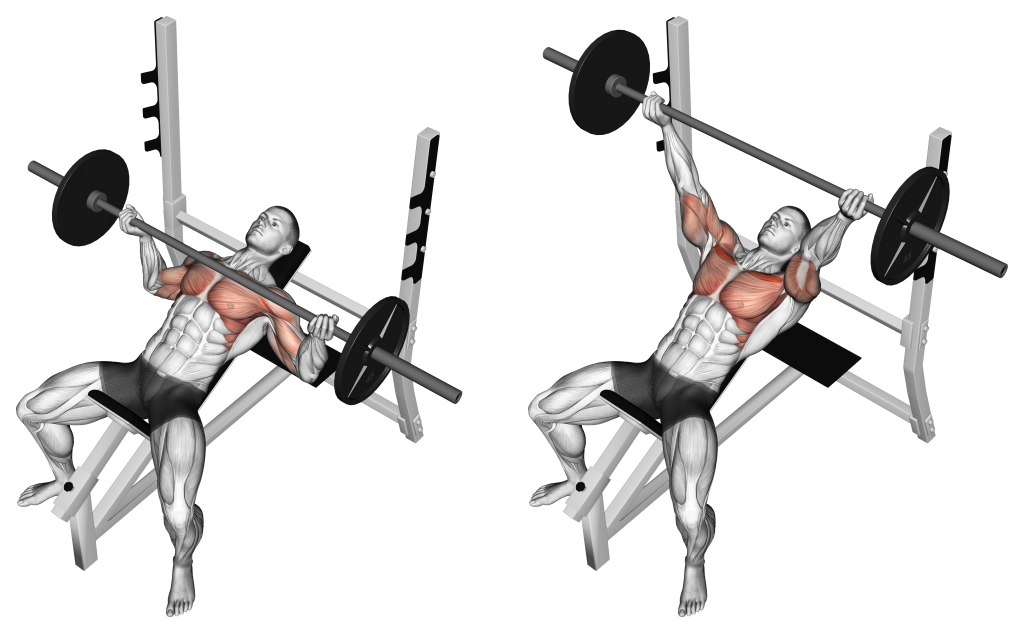
Like the flat or decline press, the incline bench press calls for the hands to be set around shoulder-width apart. Conversely, the incline bench press’ touch point is higher along the chest, rather than at mid-chest or sternum.
Now in the correct stance, the lifter will unrack the bar and slowly lower it towards the top of their chest, ensuring the elbows are tracking beneath the bar as they do so.
Once the bar touches the chest, the lifter presses through their palms and extends their arms back upwards - thereby completing the repetition.
4. The Close-Grip Bench Press/Tricep Bench Press
An accessory bench press variation performed so as to target the triceps more; the close-grip bench press or “CGBP” is performed similarly to a flat bench press, only with the hands set shoulder-width apart or narrower.
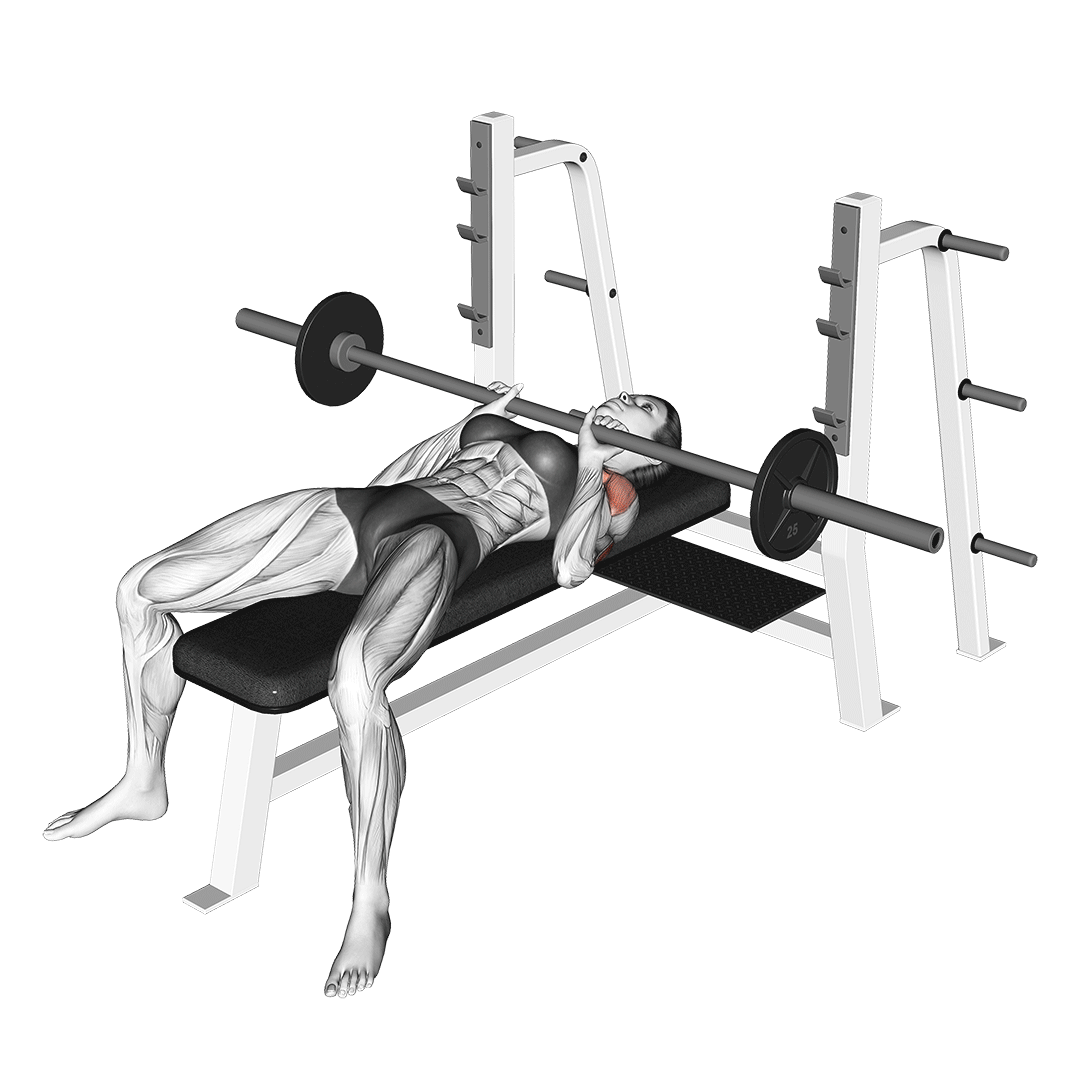
This change in hand placement creates a wider range of motion, reduces pectoral muscle recruitment and reduces maximal loading potential - hence its use as an accessory movement for triceps isolation, rather than as a main compound exercise.
Muscles Worked
The close-grip chest press primarily targets the triceps brachii, but will also recruit the pectorals and anterior deltoid head in a secondary role.
Benefits as a Bench Press Variation
As mentioned previously, the CGBP’s main benefit is its capacity to build triceps brachii strength and mass in a highly intense manner. This is especially true for the lateral and medial heads of the triceps, of which work the hardest during the exercise.
How-to:
To perform a close-grip bench press, the lifter will lie atop a bench, pinning their shoulder blades beneath them and setting their feet on the floor. The hands should be positioned shoulder-width apart or narrower along the bar, elbows kept close to the sides of the torso throughout the repetition.
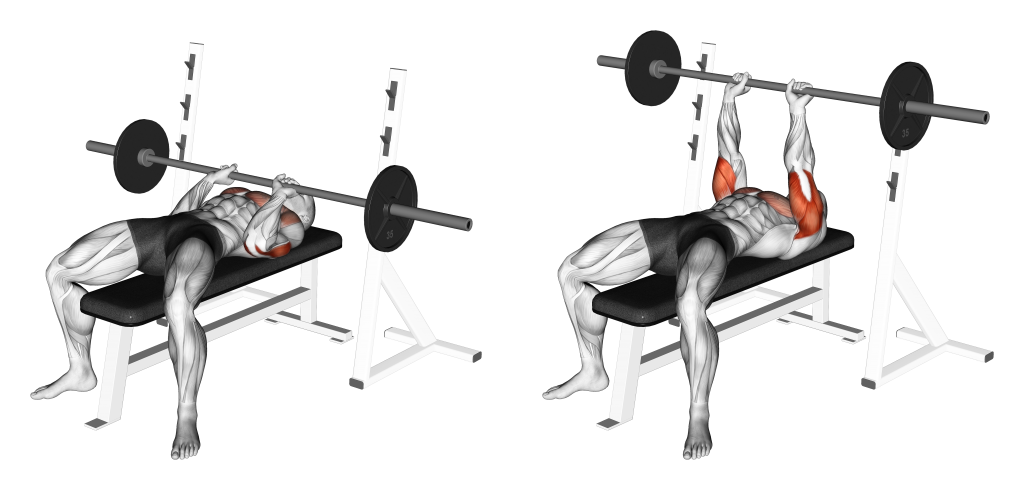
Now in the correct stance, the lifter unracks the bar, lowering it towards the middle of their chest as they bend at the elbows. The lifter should avoid bending the elbows out to the sides, instead focusing on keeping them pointed in the same direction as the legs.
Once the bar touches the chest, the lifter contracts their triceps brachii and extends their arms back upwards.
The repetition is complete when the elbows are fully straightened over the torso.
5. The Wide-Grip Bench Press
Just as there is a close-grip bench press, there is also a wide-grip bench press - the latter being a variation meant to elicit greater pectoral muscle recruitment in exchange for less involvement of the triceps brachii.
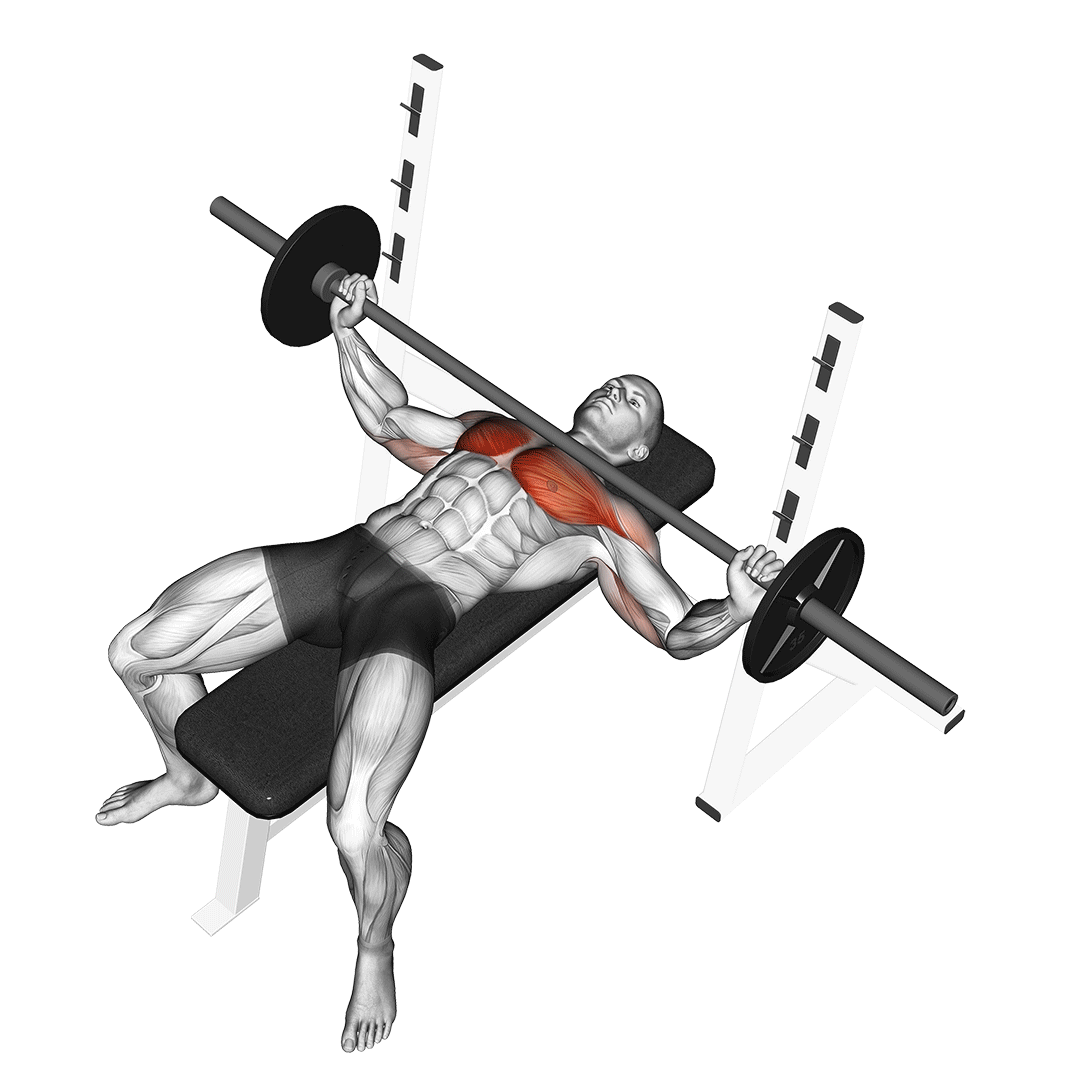
As one can guess from its name, the wide-grip press involves placing the hands significantly wider than shoulder-width apart - sometimes twice the width, even.
Like the close-grip variant, the wide-grip bench press is less often used as the main form of bench press and instead as an accessory exercise for maximizing chest muscle development.
Some controversy surrounds the wide-grip chest press due to the supposed greater risk of shoulder injury it involves. So long as a proper warm-up and correct form is followed, this risk can largely be mitigated.
Muscles Worked
The wide-grip bench press primarily targets the pectoralis major and minor - while also working the anterior deltoid as well. In comparison, the triceps play less and less of a role the wider the hands are placed.
Benefits as a Bench Press Variation
The wide-grip bench press, as mentioned earlier, is used to maximize recruitment and development of the pectoral muscles. This is primarily due to a reduced emphasis on other muscles, forcing the pecs to work harder.
Muscular recruitment notwithstanding, the wide-grip variant of the chest press also features a significantly shorter range of motion, allowing for greater amounts of weight to be lifted.
How-to:
To perform a wide-grip bench press, the lifter will first assume the standard bench press stance by lying on the bench with their scapula retracted, glutes pressed against the bench and heels set flat on the floor.
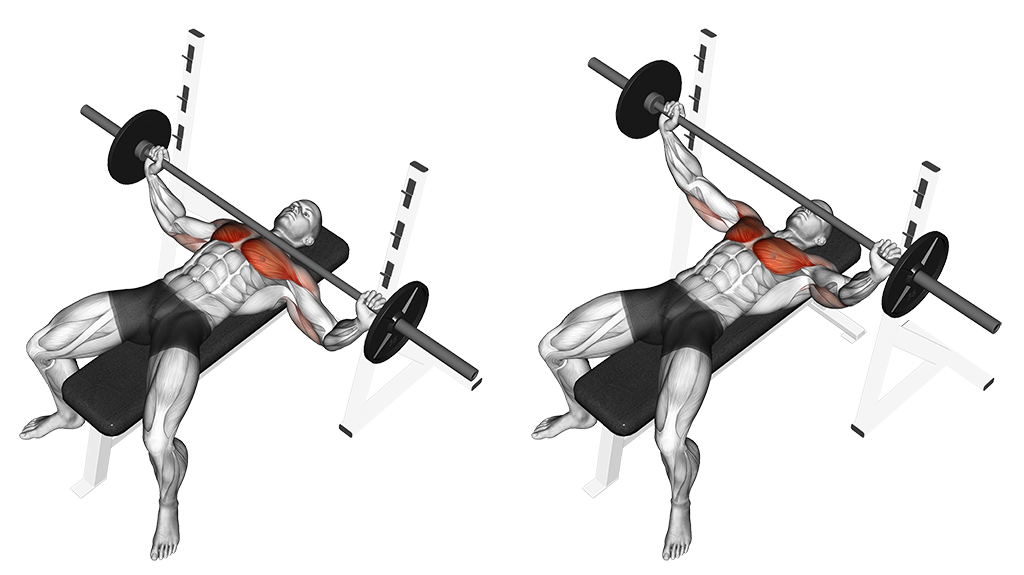
Setting the hands as far as 1.5-2 times shoulder-width apart (depending on proportions and preference), the lifter will unrack the bar and hold it over the upper section of their chest.
Lowering the bar until it touches somewhere around the upper section of the chest, the lifter will then squeeze their pectoral muscles and extend their elbows upwards - thereby completing the repetition.
6. The Floor Press
The floor press is an alternative to the chest press where no bench is used. Instead, the lifter will lie on the floor, greatly shortening the exercise’s range of motion and altering the usage of certain mechanics.

Because the floor press does not use a bench, it is technically not a bench press, but nonetheless shares many features, mechanics and a comparable muscular recruitment pattern to other bench press variations.
Muscles Worked
The floor press primarily targets the triceps brachii. To a lesser extent, the anterior deltoid muscles will also be targeted.
However, unlike other bench press variations, the floor press features far less pectoral muscle recruitment. This is due to the shortened range of motion involved.
Benefits as a Bench Press Variation
Apart from being used as an alternative when no bench or barbell rack is available, the floor press is occasionally used by weightlifting athletes who suffer from poor lockout or sticking points during the conventional bench press.
Occasionally, the floor press is also used to train around certain types of shoulder injuries, or otherwise to maximize triceps brachii development.
How-to:
To perform the barbell floor press, the lifter will slide beneath a loaded barbell on the floor, retracting their shoulderblades beneath them and setting their hands slightly wider than shoulder-width apart.

Pressing the barbell upwards, the lifter will then slowly lower their elbows towards the ground, tucking them in slightly as they do so. As the elbows come close to the floor, the lifter will decelerate the bar by squeezing their pectoral muscles - stopping once the triceps touch the ground.
With the arms now on the ground, the lifter will squeeze their triceps and press the bar back upwards - thereby completing the repetition.
7. The Board Press
Like the floor press, the board press is a specialized bench press variation performed so as to correct certain issues in conventional bench press execution. These are most often sticking points or poor stability, and are corrected with the board press by shortening the range of motion involved.
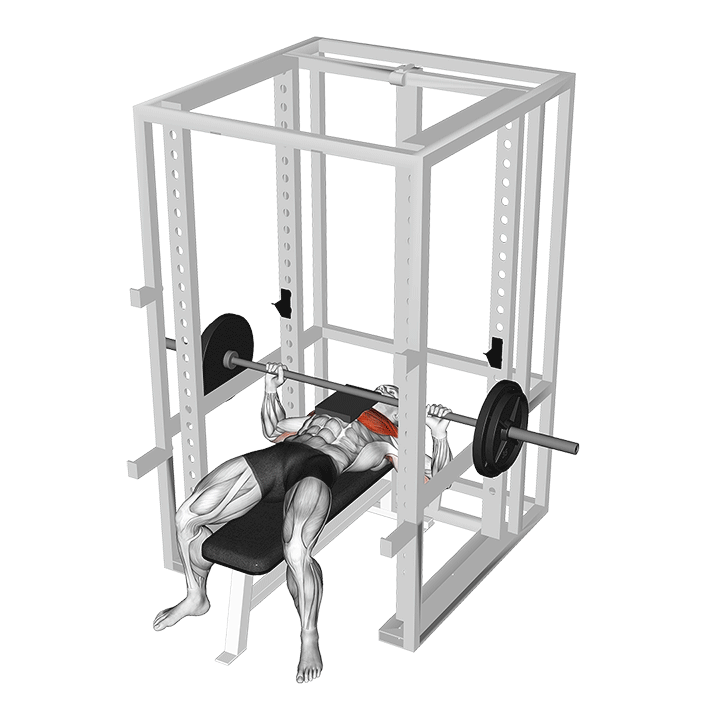
The board press makes use of a block or board placed on the lifter’s chest as they perform an otherwise ordinary flat bench press. This board will stop the barbell before it actually touches the lifter’s chest, forcing them to arrest their momentum and emphasize different muscles.
Muscles Worked
Depending on the height of the board press, the pectorals may or may not be the main mobilizer muscle used during the exercise. The higher the height of the block or board, the less the pectorals are used.
Regardless, the triceps and anterior deltoids will also play a primary role as well.
Benefits as a Bench Press Variation
The board press is primarily used to correct sticking points, poor stability or lift-off issues with the conventional bench press. This is particularly important for powerlifters and other competitive strength athletes.
In addition, the board press can also be used to create a more triceps-focused alternative in much the same manner as a floor press.
How-to:
To perform a repetition of the board press, the lifter will enter the standard flat bench press stance by lying atop their back, retracting their scapula and pinning the hips against the bench.
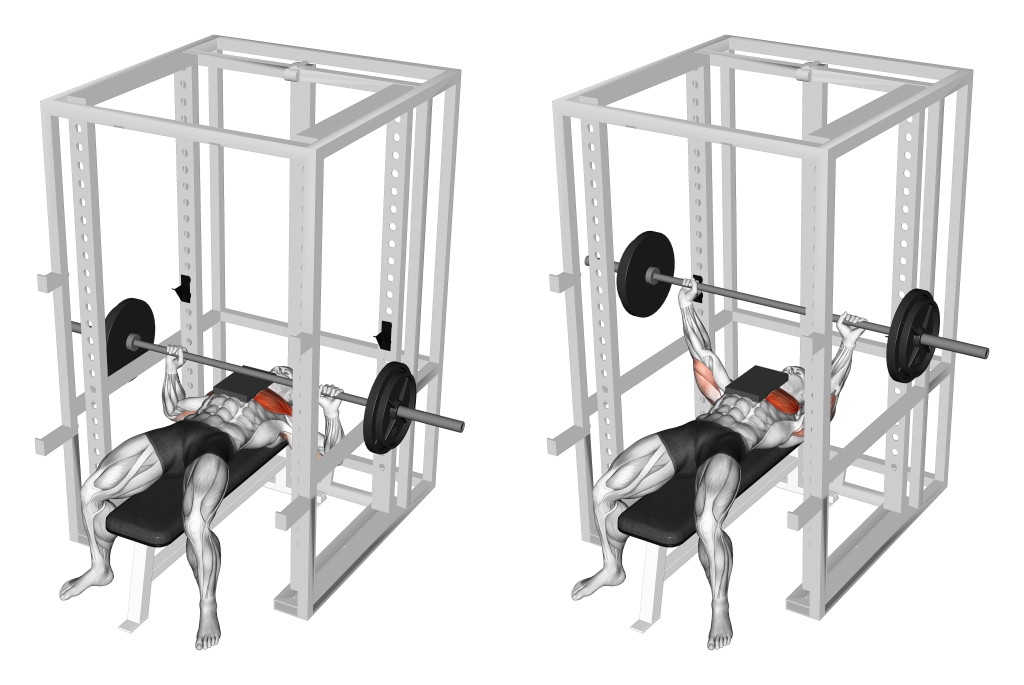
A board should be placed flat along the center of their chest, its height according to the specific sticking point the lifter is experiencing.
Board now placed on their chest, the lifter will proceed to perform the bench press as normal. Rather than lowering the bar to their chest however, the lifter will instead decelerate the bar as it approaches the board - stopping once it touches it.
Bar now resting on the board, the lifter will then explosively press upwards so as to return to full lockout. This completes the repetition.
Which Bench Press Variation is The Best?
Although quite a number of bench press variations exist, it is best to first master the conventional bench press prior to attempting more advanced versions.
Once you’ve done so, pick a bench press variation that best fits your training needs while simultaneously targeting the push muscles of your upper body.
This means avoiding exercises that are too narrow in scope (unless needed), such as the board press or close grip bench press. These can instead be used as supplementary exercises for correcting weaknesses in your training.
References
1. Shepard, Greg., Goss, Kim. Bigger, Faster, Stronger. United States: Human Kinetics, 2017. ISBN: 9781492545811, 1492545813
2. Rodríguez-Ridao D, Antequera-Vique JA, Martín-Fuentes I, Muyor JM. Effect of Five Bench Inclinations on the Electromyographic Activity of the Pectoralis Major, Anterior Deltoid, and Triceps Brachii during the Bench Press Exercise. Int J Environ Res Public Health. 2020 Oct 8;17(19):7339. doi: 10.3390/ijerph17197339. PMID: 33049982; PMCID: PMC7579505.
